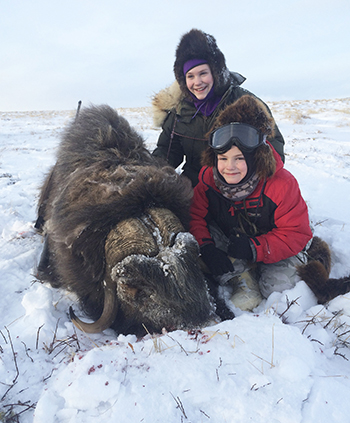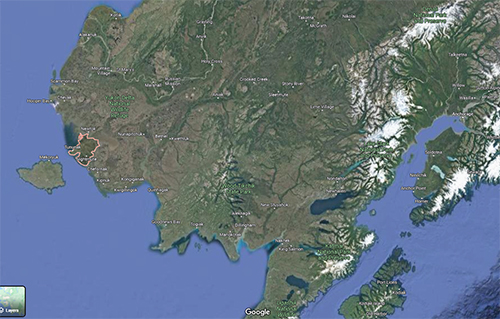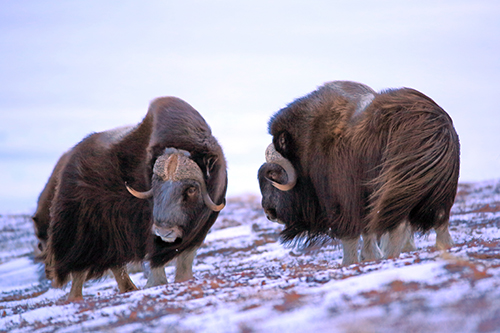Alaska Fish & Wildlife News
May 2023
Keeping Nelson Island Muskox Population on Target

Managing a population of muskox on an island in Western Alaska has not always been easy. Sometimes there’s been too much of a good thing.
Muskox were introduced to Nelson Island in 1967 and 1968, when a total of 23 animals were transferred from nearby Nunivak Island. Those Nunivak Island muskox were the first muskox re-introduced to the wild in Alaska (in the 1930s) after their extirpation decades earlier, and they were thriving. Nelson Island, about 25 miles northwest and similar in geography, was an obvious location for transplanting more animals. Nelson Island was also advantageous in that it was separated from the mainland only by a river, meaning muskox could potentially migrate there once the island population took root.
There are four villages on Nelson Island (Toksook Bay, Tununak, Nightmute, and Mertarvik, which is the chosen location for the relocation of Newtok). These villages comprise a total island population of just under 1,200 residents. At the time of the reintroduction, most of Nelson Island was administered by the Bureau of Land Management, with the remaining 20 percent a national wildlife refuge administered by the US Fish and Wildlife Service (Clarence Road National Wildlife Refuge). A few years later, with the passage of ANCSA in 1971, most of Nelson Island was selected by local villages.
The attitude of locals toward muskox was initially tepid. “At first, people thought they were a nuisance,” said Richard Curtis, a resident of Toksook Bay and longtime hunter. “People didn’t really like them because they were afraid of them… But over the years, the attitude has changed, they look at them as a resource, due to hunting.”
With the drafting of the 1995 Nelson Island Cooperative Management Plan, a collaboration between local corporations, the Alaska Department of Fish and Game (ADF&G), and the US Fish and Wildlife Service, muskox permits were to be distributed on a rotational basis between the villages on Nelson Island, as well as nearby Chefornak.

“The purpose of this management plan was the continued joint commitment to manage for a sustained yield of muskox,” said Patrick Jones, the ADF&G biologist based in Bethel. “It also laid out harvest management and emphasized no hunting when less than 250 muskox were present, and thirdly, it asked to maintain the habitat and ecosystem of the island for long-term use.”
Curtis recalled his first muskox hunt, the very first year the opportunity was offered. “It was different then, they put everyone’s name in a hat and drew names,” he said. “The reason I went, my sister-in-law’s name was drawn, and so I took her on the snowmachine, and we shot her muskox.”
Curtis remembered long lines as more residents realized the food value of muskox. “It’s very competitive,” he said. “I’ve sat in line for three or four days. I looked at it as a meat resource, and I wanted a permit.” Many Nelson Island residents prefer muskox to moose because it is richer and tastes less gamey. “I’m one of those, I like muskox better than moose,” he said.
The ideal forage conditions and lack of natural predators allowed the muskox population to expand. “By all definitions muskox have thrived on Nelson Island,” Jones said. “Most years recruitment and survival of calves ranged from 16 percent all the way up to 38 percent, with a long-term average close to 25 percent.” In the years between 1981 and 2023, there were only three years where the population dipped below 250 animals, the lower management objective. “Some of that was from unregulated hunting, and some of that was from animals leaving the island during the winter, when the water surrounding the island freezes, effectively attaching it to the mainland.”

By 2009, the muskox population had jumped to 541 animals. As muskox continued to proliferate, it became clear that the number of permits that the Department was allowed to issue were not enough to control the population. Due to statutory regulation, ADF&G was only allowed to issue 42 permits.
“At the time, we were okay with that, in hopes muskox on the island would reach some kind of social carrying capacity, and start dispersing off the island onto the mainland,” Jones said. While a few muskox had decided to leave the island, the mainland population initially was slow to share the success of Nunivak or Nelson Islands, possibly due to illegal harvest and accidental death. Jones recalled several times where mainland muskox were found drowned after falling through thin ice, and on a couple of occasions after freezing rain events, muskox that had been lying down were literally found frozen in place, unable to get up.
Meanwhile, the vast majority of muskox on Nelson Island seemed content to stay put – despite overcrowding. As the population skyrocketed to 1,000 animals, at times they occupied only a small corner of the habitat.
“By 2013 we realized the population was now growing at too fast of a rate, and our original hypothesis of a social carrying capacity was not holding out,” Jones said. “They weren’t even occupying the entire island with 1,000 animals, much less moving off the island.” The density approached 1.9 animals per square kilometer, and biologists were worried about overgrazing and destruction of the range habitat, and a possible population crash.

In 2014, the Board of Game removed the 42-permit cap, giving biologists the tools they needed to bring the herd down to a sustainable level. Through research and observation, ADF&G staff determined that the upper population limit should not exceed 450 pre-calving animals. Between 2014 and 2018, ADF&G issued up to 300 permits a season to reduce the population from 979 to 380. Since 2018, enough permits have been issued to maintain the population above 250, but below 450.
Given that managers now can issue enough hunting permits to control the population, the only missing piece of the operation is to actually track the number of muskox. And while Nelson Island doesn’t have trees, it is a large area, and mountainous.
“The first few surveys in the ‘70s were done by airplane,” Jones said. “For a time, in the ‘80s, snow machines were used, but ultimately aircraft was decided to be more effective and cost efficient.” To accurately count animals, biologists conduct a census, or a complete count. The idea is that with enough passes and adjacent flight paths, all muskox on the island can be counted. This is different than some other aerial wildlife surveys, such as those frequently done for moose, where not all areas are flown, and not all moose can be observed due to vegetation. In those instances, statistics are needed to approximate a population.
“The short version of the survey is that we divide the island into transects, and these transects are varying distances depending on the topography. The goal of the transect is that we can see one transect from the last, and detect all the muskox groups on the island,” Jones explained. With muskoxen remaining dark and not shedding until later in summer, the ideal time to spot them seems to be June and July, when they stand out against the green grass.

Once the groups are spotted, the airplane flies over the animals and they are photographed with digital cameras. Because muskox have characteristic horn growth patterns, the age and sex can usually be determined. Taking the bull-cow ratio of the population is important, as there need to be enough bulls in the population to breed with all available cows.
Despite the challenges of re-introduction, muskox have proven to be a valuable resource. “I always looked at muskox as a way to fill my freezer,” Curtis said. Now in his 70s, he stopped hunting muskox only about five years ago. But the subsistence tradition continues. "My younger son is in his thirties, and he usually lines up for us. I look at it this way, as long as we get one muskox for the freezer… for the family,” he said.
Keane Richards is Education Specialist for ADF&G Region 5 and lives in Nome. He enjoys exploring Western Alaska’s backcountry, and all of the subsistence opportunities it affords him and his family.
More on muskox
Captive muskox and exquisite qiviut
Subscribe to be notified about new issues
Receive a monthly notice about new issues and articles.
